Making your own backpacking meals can be fun and a great way to take control over your nutrition while saving money. Store-bought freeze-dried meals are convenient and lightweight, but they can be expensive and full of preservatives. Follow the steps below to learn the basics of food dehydration, then try some of our favorite recipes for inspiration. After that, you can start experimenting to turn your own recipes into delicious instant meals you can take anywhere. Whether you just need a couple dinners for a weekend outing or you’re preparing months of meals for a thru-hike, we’ll get you primed to start cooking and packing for your next adventure right away.
No Time Right Now?
Not ready to make your own backpacking meals and just want to know which store-bought meals are the best? Get the skinny on our Best Freeze-Dried Backpacking Meals list. If you like this article, you might also like this popular CleverHiker content:
- CleverHiker Backpacking Gear Guide
- CleverHiker Top Gear Picks
- Essential Trail Skills Videos
- Lightweight Gear Foundations Videos

Backpacking Food Basics
If you’re just getting started and want an idea of what other backpackers eat for breakfasts, lunches, dinners, and snacks, check out our Best Lightweight Backpacking Food guide featuring a video covering the foundations of Ultralight Backpacking Food.
Backpacking Nutrition
Forget everything you’ve learned about limiting your consumption of calories and turn it on its head. Backpacking is an endurance sport and your body needs plenty of carbs, proteins, and fats to sustain its energy and help you recover. The healthier you feed yourself on the trail, the better you’ll feel and perform.
Food Weight
Keeping your pack weight to a minimum is really important on multi-day trips, but also try to have a good balance of foods that you enjoy and make you feel good. The goal is to create meals that provide the most calories and nutrition with the least amount of weight. Look for rich, calorically-dense foods (100+ calories per ounce) that offer real hunger-crushing value and keep you fuller for longer. Think “less volume, more substance”. Adding oil and/or butter is another excellent way to supplement your caloric intake and make your meals taste great too.
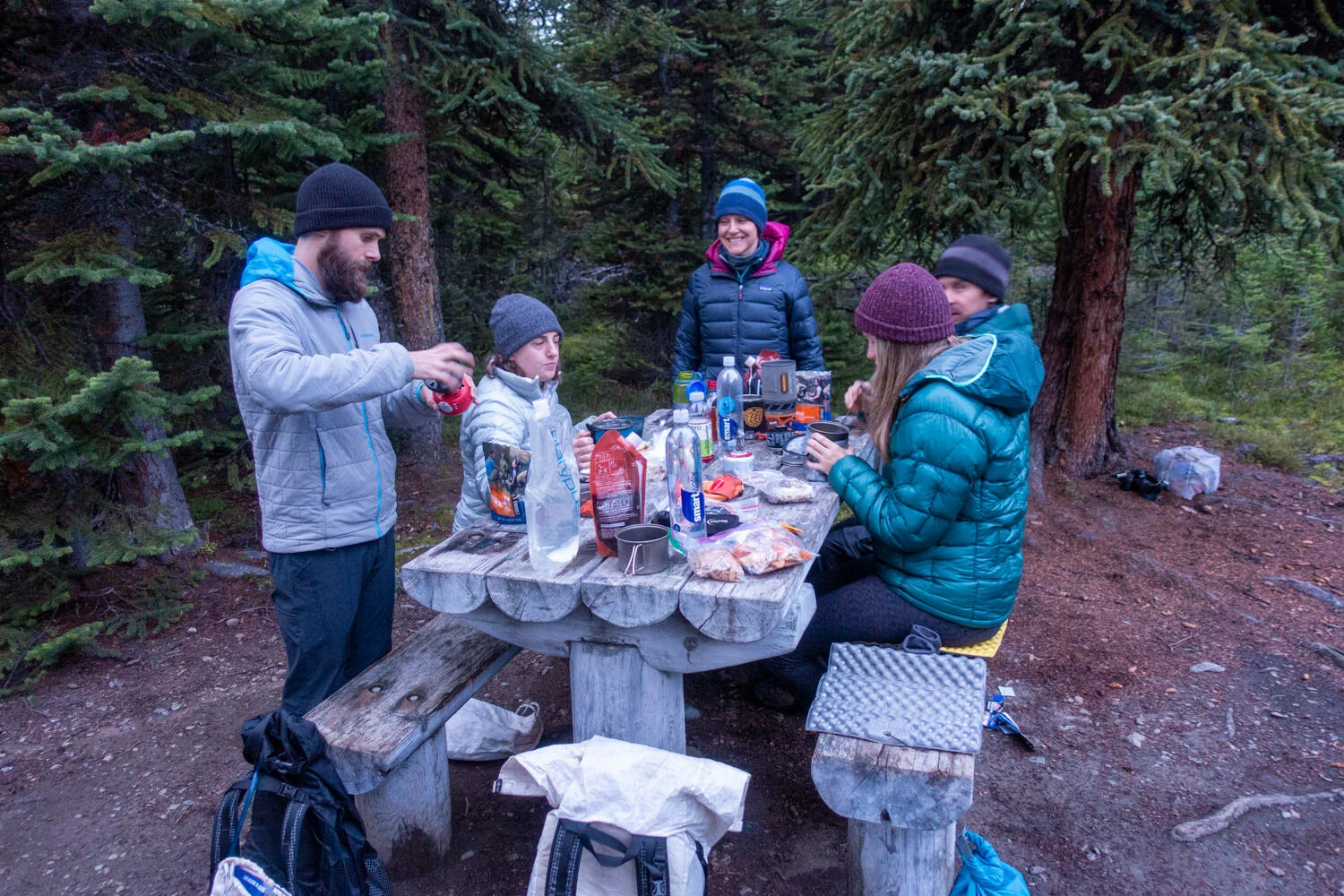
Making Your Own Backpacking Meals
There are three ways in which you can make your own backpacking meals, ranging from fairly easy to complex. Below we’ll outline the process for each method, as well as highlight our favorite recipes for each method.
- OPTION 1: Combining dried goods (no cooking at home required)
- OPTION 2: Dehydrating individual ingredients and assembling them into meals (cooking and dehydrating required)
- OPTION 3: Cooking and dehydrating whole meals

USING A SCALE TO PORTION OUT FOOD WILL GIVE YOU THE BEST RESULTS.
Portioning Food: How Much is Enough?
A small lightweight bowl and a digital scale make portioning meals easy, especially since many dehydrated foods are tough to accurately measure with cups/spoons. We’ve found that a 100-gram meal is usually sufficiently filling for an average hiker, and 150 g is satisfying for a large or very hungry hiker. We recommend experimenting at home to find out how big you want your meals, since carrying out wasted food or going hungry is a major bummer. Keep in mind that it may not look like a lot in the bag, but when the ingredients rehydrate, they expand substantially.
To Measure Out Portions:
To Measure Out Portions:
- Place a small lightweight bowl on your digital scale and power the scale ON
- If the weight of the bowl is being measured, press ‘TARE’ to zero it out
- Switch the mode to grams
- Slowly pour dried food into the bowl until you reach the desired weight
- Add the contents of the bowl to a Ziploc and move on to the next food - Aim for a ratio of ⅓ protein, ⅓ starch, and ⅓ sauce/vegetables, etc. for a total of about 100-150 grams
- Add spices or flavorings with measuring spoons
- Package condiment packets or anything extra to go with each serving in a small bag

VACUUM-SEALING YOUR MEALS CAN SAVE SPACE IN YOUR PACK AND ALLOW YOU TO “COOK” IN THE PACKAGE.
Repackaging
It’s best to measure and repackage ingredients at home to minimize the amount of wrappers and garbage you’ll have to carry on the trail. Use heavy-duty Ziploc-style bags for short-term use (2 weeks or less), or vacuum-seal your meals for longer-term storage. Use a permanent marker to label your servings with the date, recipe title, and the approximate amount of water to add. Package small bags of toppings, condiments, oil packets, etc. with your meals so you don’t forget them. Alternatively, mark the bags with reminders (example: “Add tortillas from freezer,” or “add tuna packet”).
The Benefits of Vacuum-Sealing - Vacuum-sealed meals are compact, low-odor, and the bags are durable enough to hold boiling water to cook your meals. Properly dried and vacuum-sealed meals last for months at room temperature, but they can also be kept in the freezer (stops all biological processes) until you need them for up to a year. If you plan on making quite a few dehydrated meals, it’s worth it to invest in your own vacuum-sealer, as well as a supply of vacuum-seal roll / bags.
Sealing Tip - Pasta, rice, or other “sharp” ingredients may create pin holes in vacuum-sealer bags that allow oxygen to cause spoilage. As a precaution, you can add a layer of parchment paper between the food and plastic on meals you suspect may cause problems. Simply measure a piece of parchment paper twice the length of your meal, fold it in half, and insert it into the sealer bag. Pour food into the center and seal as usual.
Tips to Reduce Waste - Dehydrating is a great way to save food that might otherwise go to waste, but sadly, it’s easy to create a lot of garbage when buying and repackaging food. The most eco-friendly way to purchase ingredients for making backpacking meals is to buy in bulk at the grocery store. Bring or buy reusable containers to purchase bulk foods whenever possible and try to recycle packaging. Wash lightly used Ziploc bags and dry them by hanging them upside-down (open) with a magnet on your refrigerator.
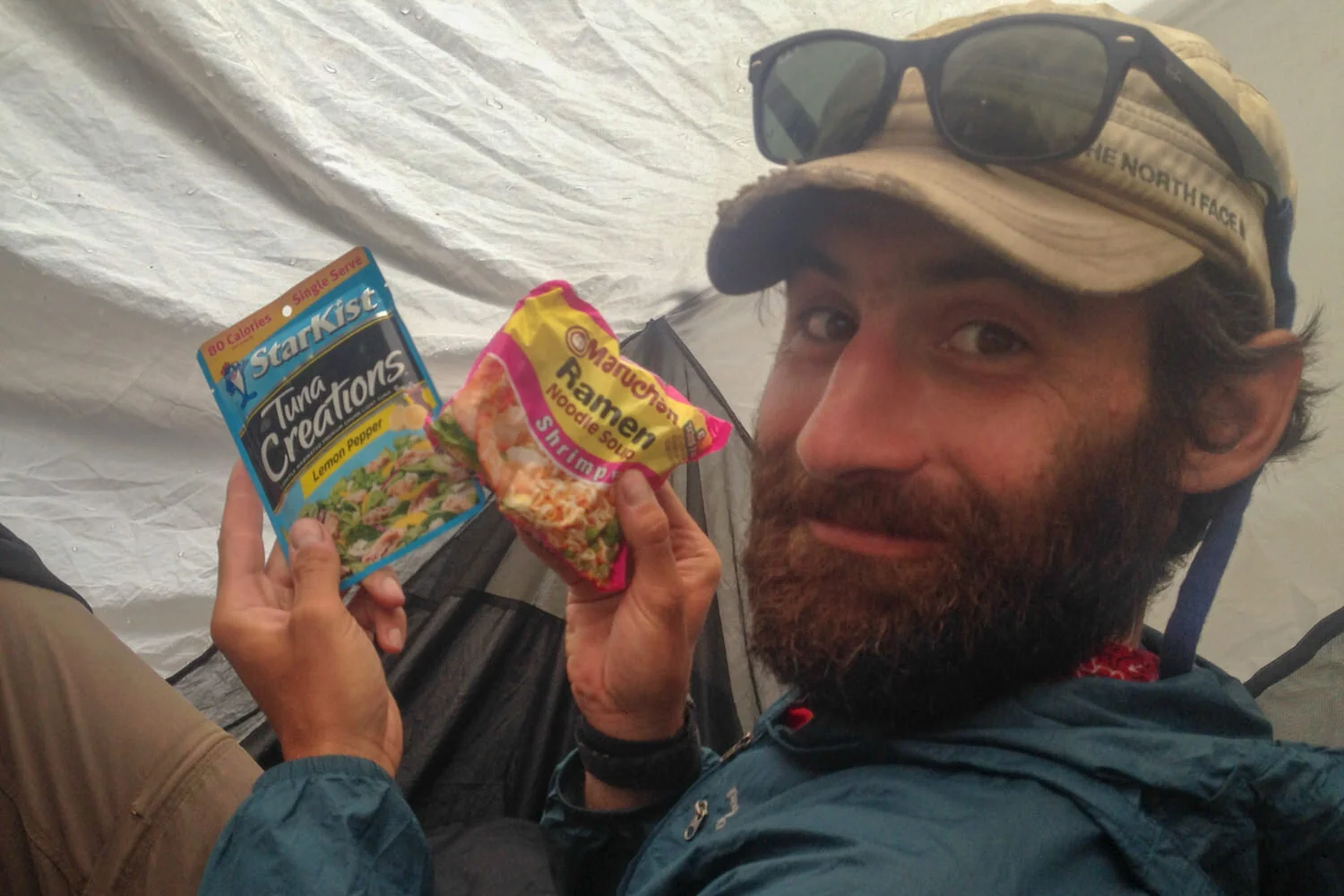
THE EASIEST OPTION IS TO COMBINE DRIED OR PREPACKAGED FOODS TO MAKE YOUR OWN CREATIONS.
option 1: COMBINING DRIED GOODS
A very simple and easy way to start making your own backpacking meals without doing any cooking is to buy pre-dried ingredients that are readily available in grocery stores. Blend proteins, starches, and spices together to create unlimited combinations.
DRIED FOODS AVAILABLE IN GROCERY STORES:
- Instant grits
- Peanut butter powder
- Powdered milk
- Protein powder
- Cheese powder
- Powdered eggs
- TVP (textured vegetable protein)
- Quinoa
- Real bacon bits
- Jerky
- Refried beans
- Hummus
- Instant potatoes
- Instant rice
- Stuffing mix
- Dried fruit
- Dried vegetables
- Pasta/Ramen/Couscous/Rice noodles
- Mac and cheese
- Instant oatmeal (can be savory too)

BUYING DRIED GOODS IN BULK CAN SAVE MONEY.
ORDER ONLINE OR IN SPECIALTY STORES:
- Coconut milk powder (Asian market)
- Dried shrimp (Asian market)
- True Lemon
- True Lime
- Butter powder (try using it to make “bulletproof” coffee on strenuous trips)

DEHYDRATE SRIRACHA COINS TO ADD SPICE TO ANY MEAL.

PACKING CONDIMENTS IS A GREAT WAY TO JAZZ UP YOUR MEALS.
CONDIMENTS TO CARRY OR PACK WITH MEALS
- Salt and pepper (packets or small shaker)
- Oil in small bottle or packets
- Ghee packets
- Soy sauce packets
- Hot sauce (small bottle or packets)
PROTEINS - Pre-dried proteins are a bit tougher to find in regular grocery stores, but it’s easy to prepare your own using a food dehydrator (see “How to Dehydrate Meats” below), or you can order freeze-dried meats from websites like Thrive Life and Wise Food Storage. Buying freeze-dried meats can be a bit expensive, but they are usually a good value since they last almost forever and you’ll get a lot of servings out of a large can or pouch you buy.
HEAVY BUT EASY PROTEIN ADDITIONS - Another popular, but heavier protein option is to pack summer sausage, chicken, tuna or salmon packets to add to meals on the trail. Nut butters (also available in packets) are on the heavy side as well, but they pack a punch of healthy fat and compliment dishes with delicious rich flavor and creamy texture.
Recipes that Require Zero Cooking at Home
All measurements in the following recipes are approximate and ratios should be adapted to your preferences. The amount of water it takes to rehydrate these meals may also vary. Also, many of the following recipes use meat as protein, but they can easily be adapted for vegetarians and vegans by substituting quinoa, nuts, nut butters, legumes, TVP, soy products, etc.

Backcountry Thanksgiving Recipe
Makes: 1 serving
Print Recipe
At home, combine:
- 30 g (about ½ c) stuffing mix
- 25 g (about ¼ c) instant potatoes
- 30 g turkey jerky (dehydrated ground turkey - see below)
- 35 g (about ¼ c) dried cranberries
- 1 Tbsp celery flakes OR ⅛ tsp celery seed - not salt (optional)
- 2 tsp gravy powder
- Oil or butter (optional)
On the Trail: Boil about 1 ¾ c water, then turn your stove off. Add stuffing mixture to the pot and stir to combine. The water should just cover the mixture. Put the lid on your pot and place it in a cozy (or fleece hat). Wait about 10-15 minutes (without peaking) to make sure everything gets thoroughly rehydrated. Then check and see if a little more water or time is needed. Stir it up, and if desired, add a bit of oil or butter to add some of the tasty fat lost in dehydration back in. Enjoy and give thanks for the beauty that surrounds you!
Notes: We love this hearty savory meal as is, but if you want it to be a little less mushy you can set the potatoes apart and make them separately or in the same pot but to the side. You can also add toppings like french-fried onions or sweet potato chip crumbles for a bit of crunch.
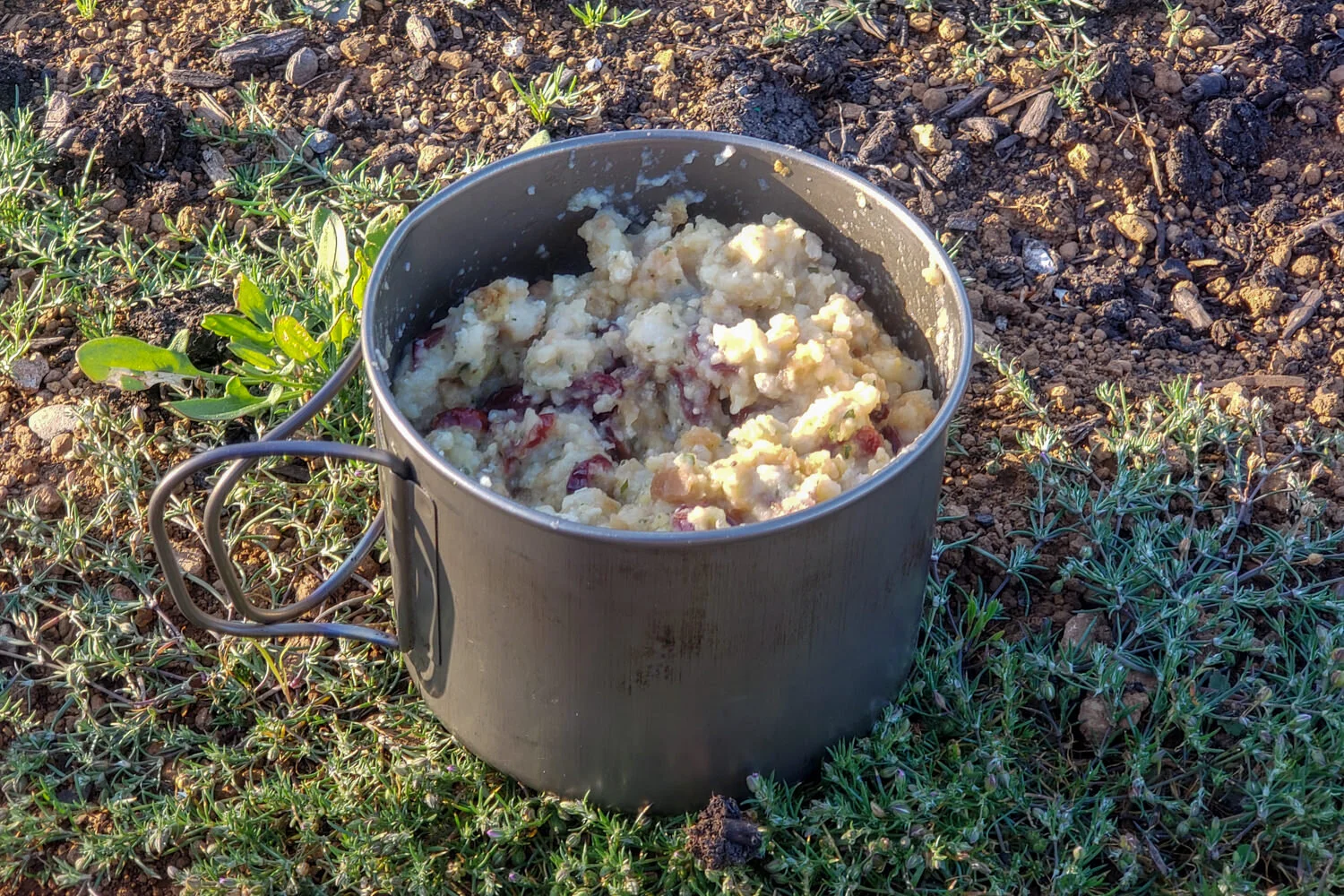
Rugged Mountain Glory Bacon and Grits Recipe
Makes: 1 serving
Print Recipe
At home, combine:
- 2 packets (total of about 56 g) Instant grits
- ½ Small bag of Real bacon bits (or dehydrated ham)
- 1 Tbsp Parmesan cheese (or fresh hard cheese/cheese stick)
- Oil or (powdered) butter (optional)
On the Trail: Boil about 1 ¼ c water, then turn your stove off. Add everything to the pot and stir to combine. The water should just cover the mixture. Put the lid on your pot and place it in a cozy. Wait about 10-15 minutes to make sure everything gets thoroughly rehydrated. Then check and see if a little more water or time is needed. Stir it up, and if desired, add a bit of oil or butter and hot sauce. Enjoy!
Notes: If using dehydrated ham, pack it in a small separate bag and pre-soak it in water to help it start softening. Boil the water, then add the rest of the ingredients as described above. You can also add a splash of color and herbal flavor by adding a tsp of dried green onions or parsley.
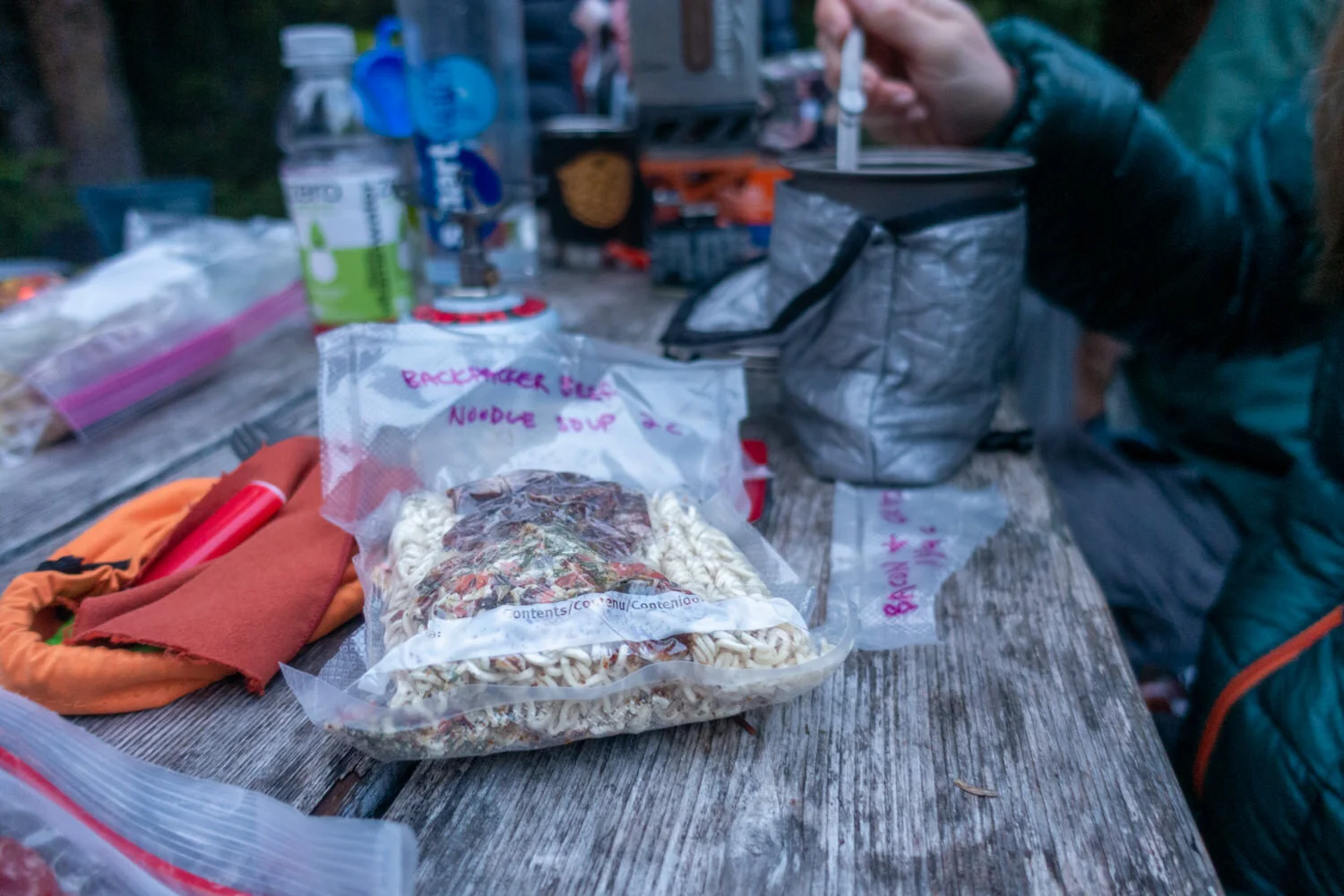
Backpacker Beef Noodle Soup Recipe
Makes: 1 serving
Print Recipe
At home, combine:
- 1 tsp vegetable, beef, or chicken bouillon powder
- ¼ c dried vegetable mix (check the spice aisle)
- 1 block (about 50 g) ramen noodles
- About 25 g low sodium natural jerky
On the Trail: Boil about 2 ½ c water, then turn your stove off. Add everything to the pot and stir to combine. Put the lid on your pot and place it in a cozy. Wait about 10-15 minutes to make sure everything gets thoroughly rehydrated. Then check and see if a little more water or time is needed. There should be a little extra liquid for a soup-like consistency. Stir, and if desired, add a bit of oil, butter, or hot sauce. Enjoy!
Notes: To make this meal feel more gourmet pack a teaspoon or more of sesame seeds in a small bag and sprinkle them over the noodles after cooking.
option 2: Dehydrating and Assembling Meals
Using a food dehydrator to dry your own ingredients will open up a world of variety where your culinary imagination is the limit. Dehydrating can be a lot of fun for those who enjoy cooking, but making your own meals and lightweight snacks doesn’t have to be complicated. Start with the basics, like raw fruits and vegetables, and add to your repertoire from there.

TOOLS YOU MAY NEED TO DEHYDRATE AND ASSEMBLE YOUR OWN BACKPACKING MEALS.
Tools You May Need
- Plastic tray liners / fruit roll sheets
- Tray screens (optional)
- Extra dehydrator trays (optional)
- Measuring cups/spoons
- Cooking utensils
- Digital scale (optional)
- Small lightweight bowl (for scale)
- Ziploc bags (various sizes)
- Vacuum-sealer (for long-term storage)
- Vacuum-seal roll / bags
- Pots / pans
- Strainer
- Parchment paper
- Permanent marker
- Mandoline slicer (optional)
- Food processor (optional)
- Meat thermometer (optional)
- Instant-Pot (optional)
- Backpacking cookpot
- Backpacking stove
- Pot cozy, REpack, or fleece hat
- Food dehydrator

How to Dehydrate Fruits and Vegetables
Buying a Food Dehydrator - There are lots of different styles of food dehydrators on the market and they range from budget to high-end, but a basic one is all you need to get started. If you love dehydrating and get really into it, you can always upgrade later. Brands we’ve used and recommend are: NESCO and Excalibur.
- Thinly slice raw fruits and vegetables as evenly as possible for fast and consistent drying. A mandoline slicer comes in super handy for this and perfectly slices produce like: potatoes, beets, carrots, onions, mushrooms, apples, strawberries, kiwis, etc.
- Lay the fruit/veggie slices on the dehydrator trays in a single layer
- Change the temperature setting on your dehydrator to 135°F and dry for several hours
- Turn them over partway through the drying process so that they dry evenly
- When the slices are completely dry, remove them from the trays and toss them into a sealable bag or container. Label them (description and date), and stick them in a cool dry place (or the freezer) until you’re ready to assemble them into meals.
How Long? The dry time will depend on the moisture content of the produce and the thickness of the slices. Check every hour or so, but don’t worry too much -- it’s tough to over dry fruits and vegetables. If you want fruit “leather, “ stop sooner.
Produce that Needs Special Attention
- Apples, Pears, and Bananas - Some fruit turns brown when exposed to air, but browning can easily be prevented by using a very sharp knife and dipping/brushing the cut fruit in lemon juice (or any juice high in citric acid) before drying
- Leafy Greens - Steaming or blanching leafy greens before the dehydration process will help ensure you get all of the vitamins and minerals from the greens.
- Mushrooms - You may rinse the dirt from mushrooms, but make sure to dry them off with a paper towel before the dehydration process begins to preserve their natural color. They may get darker after dehydrating, but also really tasty.
- Blueberries -To allow blueberries to dry properly, submerge them in boiling water for 15 to 30 seconds to crack their skin and then quickly pulled them out. A fine metal strainer makes this easy.
- Low-Acid Vegetables and Fruits - Some foods like beets and potatoes, taste better if you steam or saute them before dehydrating If you wouldn’t eat something raw, cook it first to make it more palatable (and easier to digest).

How to Dehydrate Meats
Learning to dry your own meat doesn’t have to be scary. Lean meats, properly cooked, dehydrated, vacuum-sealed, and stored, can last for months without going bad. Dehydrating your own meats drastically reduces the cost of buying freeze-dried proteins to add to your backpacking meals and reduces pack weight significantly by replacing much heavier “packets” of tuna, salmon, and chicken.
Keys to Meat-Drying Success:
- Use lean meats (excess oil and fat causes meat to go bad)
- Add breadcrumbs to ground meats while browning to help them absorb water later
- Use canned or pressure-cooked chicken (an Instant-Pot speeds the process)
- Slice cooked meats thinly (lunch meats work great)
- Dehydrate meats separately from other ingredients for best results (meat needs higher temp.)
How Much to Make: Because it’s easiest, we prefer to cook and dehydrate entire packages of meat or whole fruits and veggies, then use them to make an array of meals (or several servings of the same meal). Use a fresh-to-dry equivalency chart to estimate how much of a fresh product you need to start with to end up with an approximate amount of a dry ingredient for specific meals, but there’s always a little guess and check involved.

TIP: BLOT YOUR MEAT TO EXTRACT MOISTURE BEFORE DEHYDRATING
How to Make Jerky
- Choose a lean cut of meat
- Remove skin and bones (for poultry)
- Important: Trim the visible fat off and discard any membrane tissue (fat doesn’t dry well and can turn rancid)
- Cut into thin strips or slices, no more than ¼ inch thick (a mandoline is handy for this)
- Marinate for 6–12 hours in the refrigerator
- Pre-cook meat by either roasting or steaming until the internal temp. is 160–165°F (destroys bacteria before drying)
- Rinse the meat and spread on dehydrator trays
- Dehydrate at 160°F for 4–6 hours or until dry (it should be leathery or partly brittle when done)
- Store in Ziploc bags with air removed or vacuum-seal
- Store in a dry, dark place at room temperature for up to 2 months or freeze for a longer shelf life
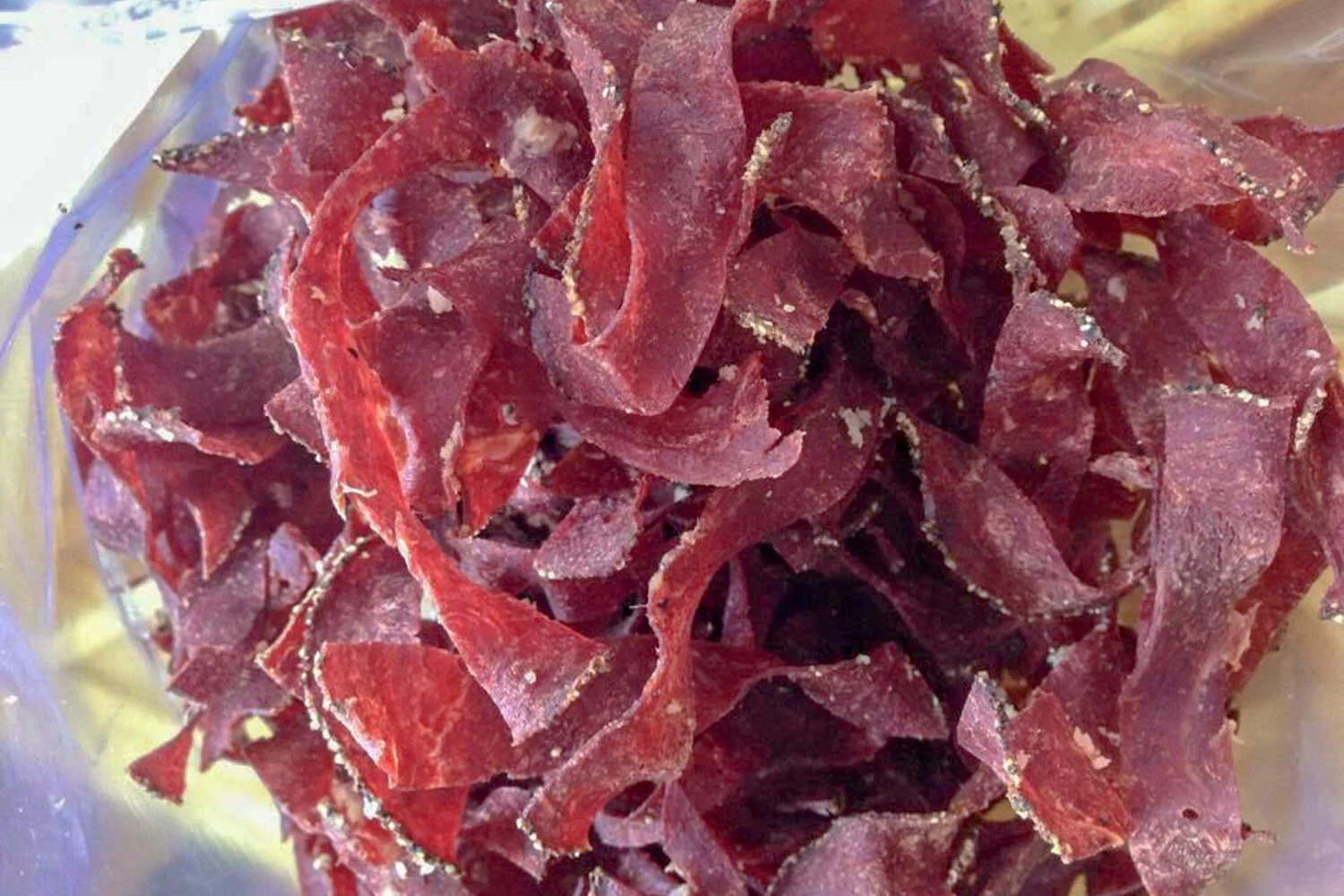
How to Dehydrate Ground Meats (Beef, Turkey, Lamb, etc.)
- Choose the leanest meat available (7-15% fat). A pound of ground beef yields about 2 ½ cups (or 5-50 g servings) dried.
- Use hands to combine breadcrumbs with raw meat to help it rehydrate properly (about ½ c bread crumbs per pound of meat)
Note: If you are drying ground meat for long term storage over 1 year, leave out the bread crumbs as they retain a small amount of the fat from the meat, but they won’t rehydrate nearly as quickly and will require boiling.
- Brown the meat in a skillet (with as little oil as possible) breaking into fine pieces
- Add seasonings as desired (or add spices to individual meals later)
- Transfer meat to a strainer and rinse with hot water to remove as much fat and oil as possible and let drain
- Spread cooked ground meat on dehydrator trays covered with non-stick tray liners or parchment paper
- Dehydrate at 160°F for 4–6 hours until completely dry and brittle (blotting excess oil off with a paper towel during the process)
- Immediately assemble into meals or store in Ziploc bags/sealed containers in a dry, cool, dark place for up to two months. Vacuum-seal or freeze meat or assembled meals for a longer shelf life.
Tip: When removing dried food from the freezer, allow it to return to room temperature before opening the container to keep condensation from forming on the food.
Chicken and Poultry - Chicken can turn rock-hard with dehydration and be especially difficult to rehydrate in backpacking meals, however, canned chicken is an exception. Follow steps 5-8 above to dry canned chicken or consider pressure cooking your own to save money. If you plan to prepare a lot of meat (including chicken) for backpacking meals, you may want to invest in an Instant-Pot, which cooks fall-off-the-bone, soft shredded meat in about 15 minutes. A pound of fresh chicken yields about 2 cups (or 4-50 g servings) dried.
Lunch Meats - Lean deli meats like ham, roast beef, and turkey are really easy to dehydrate and make excellent additions to backpacking meals. Simply cut them into thin strips and dry them at 160°F for about 6 hours, flipping once. Follow the same storage protocol above.
Tuna, Shrimp, and Seafood - We recommend dehydrating this stuff in your garage or outside since they get pretty stinky. Use solid white tuna packed in water (fattier varieties of tuna and tuna packed in oil won’t dry as well) or pre-cooked, peeled shrimp with tails off (thawed from frozen). Break tuna, shrimp, or other seafood up into small pieces and spread out in a single layer on non-stick tray liners to keep small pieces from falling through. Dehydrate at 160°F for about 6 hours or until crispy.
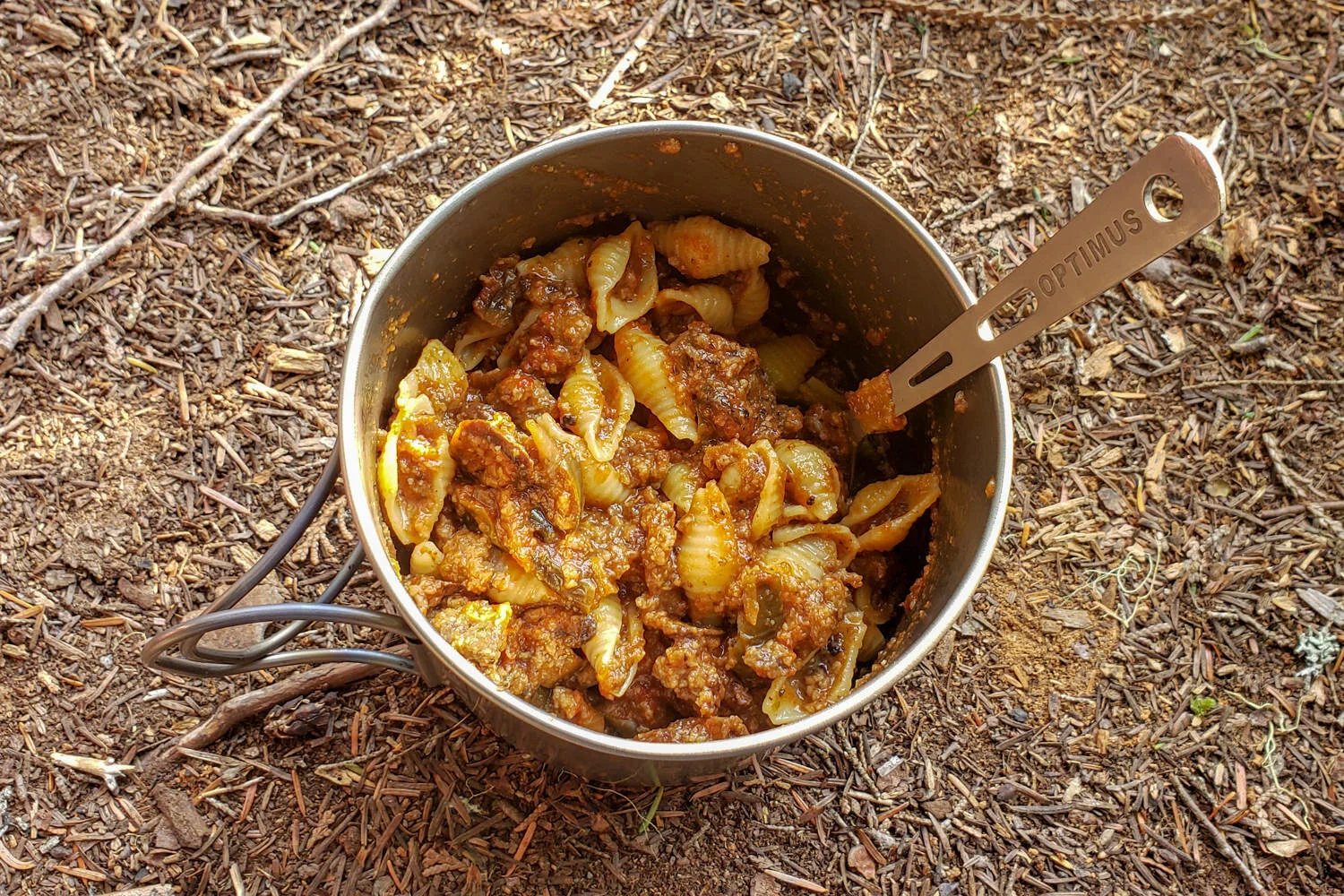
Recipes that require dehydrating & assembling
Curried Cashew Couscous Recipe
Makes: 1 serving
Print Recipe
At home: Thaw, steam, and dehydrate frozen peas or other vegetables at 135°F for 4-6 hours.
Add to a gallon-size Ziploc:
- 25 g (about ¼ c) dried vegetables (peas, carrots, etc)
- 75 g (about ½ c) couscous
- 1 Tbsp coconut milk powder
- ½-1 tsp curry powder (depending on how strong you like it)
- 1 chicken bouillon cube or powder
- ½ tsp dried cilantro (optional)
Combine in separate snack-size bag:
- 40 g (about ¼ c) golden raisins
- 35 g (about ¼ c) cashews (or slivered almonds)
- 1 nut butter packet (optional)
- oil or butter (optional)
On the Trail: Boil about 1 ½ c water, then turn your stove off. Add couscous mixture to pot and stir to combine. Put the lid on your pot and place it in a cozy (or fleece hat).Wait about 10-15 minutes to make sure everything gets thoroughly rehydrated. Then, stir it up and check and see if a little more water or time is needed. When all the water is absorbed and it’s ready to eat, add nut butter and/or oil or butter to add flavor and creamy texture. Top with golden raisins and cashews. Enjoy!
Notes: Cashews (or almonds) are an excellent source of fat and contain some protein, but If you’d like to add meat for more protein, freeze-dried or dehydrated chicken or beef taste great with this curry too.

Talus Thai Tom Yum Soup Recipe
Makes: 1 serving
Print Recipe
This soup is excellent for those days when you’re cold, feeling under the weather, or need a lighter meal. The broth infused with lemongrass, ginger, lime leaves, and thai chilies is delicious, warming, and sinus clearing. It can even help soothe an upset stomach and kick start sluggish digestion.
At home: Dehydrate a small amount of sliced mushrooms, diced tomatoes, and chopped onion at 135°F for 4-6 hours.
Add to a gallon-size Ziploc:
- 1 tom yum bouillon cube
- 25 g (about ⅓ c) dried shrimp (or chicken)
- 1-2 Tbsp dried mushrooms
- 1-2 Tbsp dried tomatoes
- 1-2 Tbsp dried onion
- 1 tsp dried cilantro
- 85 g (about 1 c) instant white rice (makes about 1 ½ c cooked)
On the Trail: Boil about 3 c water, then turn your stove off. Add all ingredients and stir to combine. Put the lid on your pot and place it in a cozy.Wait about 10-15 minutes to make sure everything gets thoroughly rehydrated. When the rice and vegetables are soft, the soup is ready. There should be plenty of fragrant liquid broth to sip and enjoy.
Notes: Though the bouillon cubes are high in sodium, they make a great hot pick-me-up spicy drink on cold, rainy days. If you’re backpacking, you’re likely sweating a lot anyway, so a little salt can be good for the body. If you like this recipe, you might also like tom ka (thai coconut chicken soup). Tom ka paste is available online or in Asian markets and can be combined with dried chicken, coconut milk powder, vegetables, and instant rice, similar to this recipe.
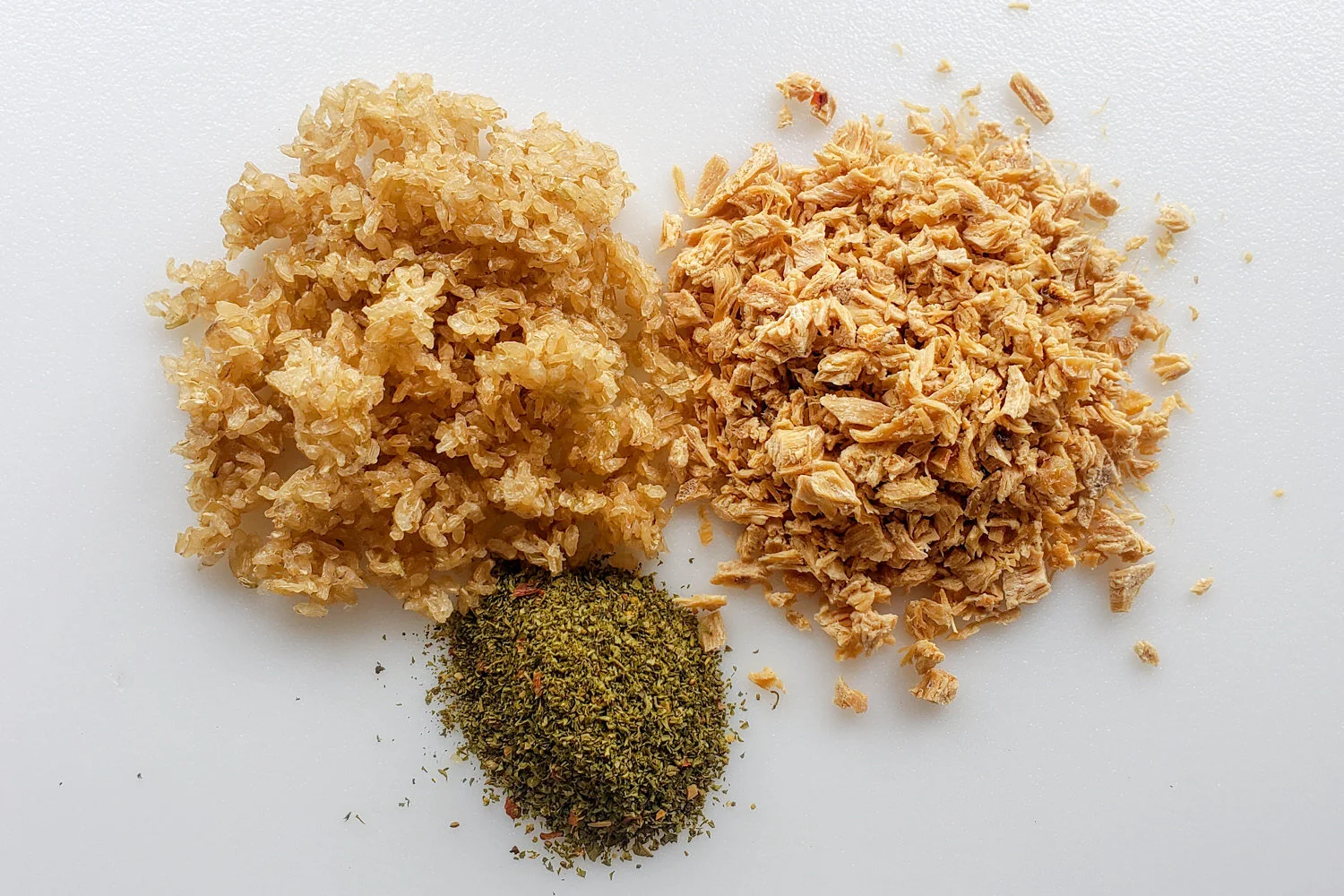
Chimichurri Chicken and Rice Recipe
Makes: 1 serving
Print Recipe
At home:
- Dehydrate ¼ lb canned or pressure cooked chicken at 160°F for 4–6 hours until dry
- Pre-cook and dehydrate rice (or use instant)
Combine in Ziploc bag:
- 2 Tbsp Chimichurri seasoning (or make your own by combining: parsley, oregano, black pepper, salt, garlic, and lemon oil)
- 50 g (about ½ c) dehydrated chicken (or dried shrimp)
- 55 g (about ⅔ c) instant rice (about 1 c cooked)
- Olive oil (available in packets - or take a small bottle)
On the Trail: Boil about 1 ½ c water, then turn your stove off. Add olive oil to the water and stir. Add seasoning, chicken (or shrimp), and rice mixture to pot. Stir to combine. Put the lid on your pot and place it in a cozy. Wait about 10-15 minutes to make sure everything gets thoroughly rehydrated. Then, stir it up and check and see if a little more water or time is needed. When all the water is absorbed and it’s ready to eat. Enjoy!
Notes: If you’re confident in your plant identification skills, a bed of foraged greens like lamb’s quarters, miner’s lettuce, and dandelion leaves make an excellent addition to this meal. If you’re unsure, err on the side of caution and abstain.
By Cleverhiker
By Cleverhiker









0 Comments